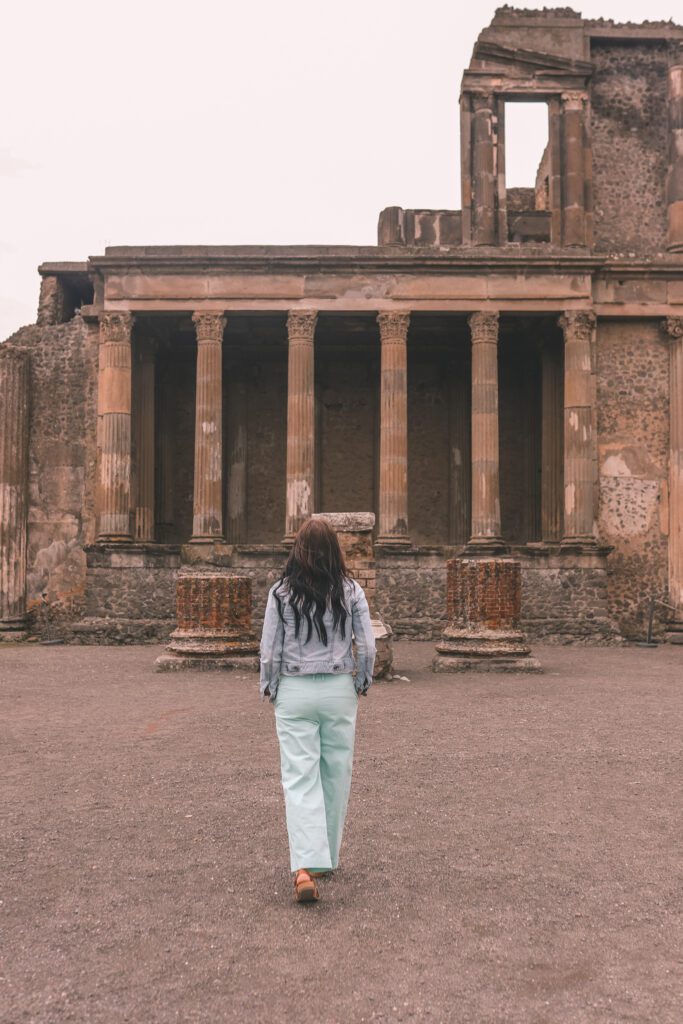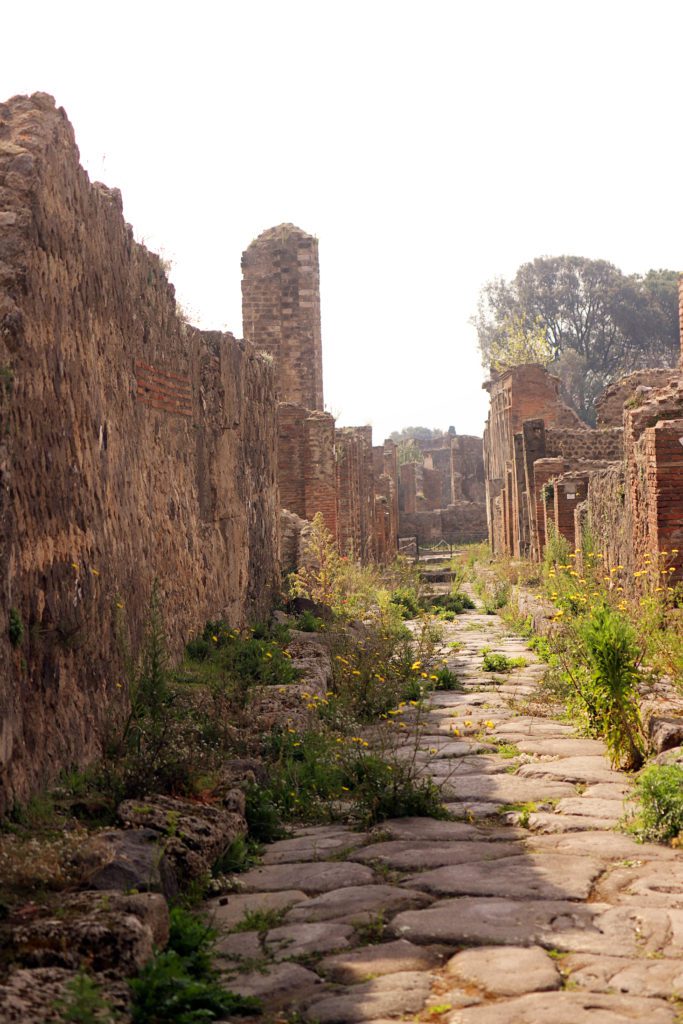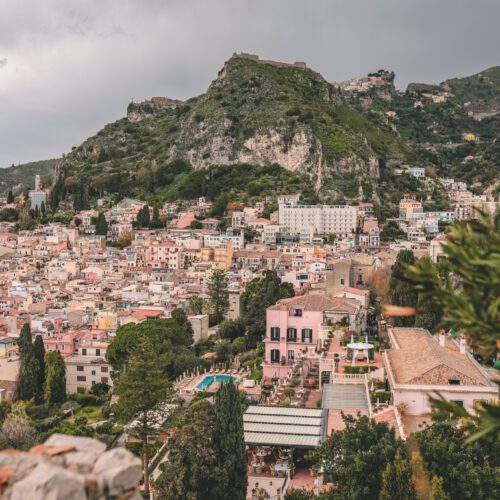Visiting the ruins of Pompeii is unlike anything I’ve ever experienced before. I was not prepared for how well the city was preserved, how advanced their society was, and how massive the archaeological site is!
We learned so many fascinating facts while we were there, and then I devoured any information I could about Pompeii after we returned home. Keep reading to discover 18 interesting facts about Pompeii that you may not know!
*Disclaimer: This post contains affiliate links. If you make a purchase through a link we will receive a small commission at no extra cost to you. Thank you for your support!
18 Interesting Facts About Pompeii
Table of Contents
- Pompeii was already an old city
- Pompeii used to be right by the water
- The population of Pompeii was around 12,000
- Suffocation and heat were the main causes of death
- Pompeii was an advanced society
- Public bathhouses were a central part of society
- Pompeii had a public laundry facility
- Original frescos and mosaics have been preserved
- Pompeii had a public irrigation system
- Small stones served as street reflectors
- Plaster casts of the bodies have been created
- The Forum was the main gathering place
- Brothels were common in Pompeii
- Mount Vesuvius is still an active volcano
- An earthquake devastated the city before the volcanic eruption
- The average life expectancy was much shorter
- Most of the artifacts are not on display in Pompeii
- Gladiator fights took place in Pompeii
- Pompeii is not the only city destroyed in the eruption
Pompeii was already an old city
Pompeii was actually 600 years old, a well-established city long before the fateful eruption of Mount Vesuvius in 79 AD.
Pompeii used to be right by the water
Pompeii was once a vibrant port city overlooking the sea. Today it lies several miles inland from the coast. The city covers approximately 170 acres, 1/3 of which remains untouched by excavation.
The population of Pompeii was around 12,000
Pompeii was a thriving city and prosperous trade center with an estimated population of around 12,000 residents. One-third of the population were enslaved people. It is heartbreaking to learn that many of their remains were found still in chains.
Suffocation and heat were the main causes of death
The cause of death was not only suffocation by the shower of ash that entombed the city within 48 hours. Although, in some areas, the ash and pumice were up to 20 feet deep.
Scientists have determined that heat was the main cause of death in many cases. With temperatures reaching up to 482 degrees Fahrenheit, the heat surges from the vent 6 miles away were hot enough to cause instant death.
Pompeii was an advanced society
Pompeii was a very advanced society. They had even discovered a rudimentary plumbing system to bring running water into some homes.
They used towers with water tanks and an aqueduct system to pipe water into the homes using gravity.
Public bathhouses were a central part of society
Public bathhouses were quite popular. They were open to all citizens, even slaves. They were a gathering place for relaxation, socializing, and personal hygiene.
The bathhouses were even outfitted with pipes in the walls and vents to create steam rooms.
Pompeii had a public laundry facility
The Fullonica di Stephanus is an excavated public laundry facility with large stone basins for washing, an upstairs terrace for drying the clothes, and even a machine to press the garments.
The clothes were cleaned with running water, as well as a special type of clay mixed with urine.
Original frescos and mosaics have been preserved
Many of the sculptures, delicate frescos on the walls, and intricate marble mosaics on the floors are still intact. It gives a sense of refinement in the wealthier areas of the city.
The homes of Pompeii’s elite featured pools, fountains, gardens, atriums, outdoor dining areas, and many of the same luxuries that can be found in homes today.
You’ll even find mosaics of large dogs on some homes that are equivalent to today’s “beware of dog” signs.
Pompeii had a public irrigation system
The streets of Pompeii are devised with an irrigation system. At the street corners, you’ll find crosswalks made of large stepping stones that would allow people to cross without stepping through the rain, sewage, and muck in the streets. You can also see the ruts in the stones made by the chariots being pulled on the streets.
Small stones served as street reflectors
If you look closely, you can spot small “cat-eye” stones laid in between the pavers on the street. These would reflect the light of the moon and help light the way home for residents out after dark.
Plaster casts of the bodies have been created
There are quite a few plaster casts of bodies and even dogs that you can find on display. Many people believe they are the actual bodies that have been preserved by the volcanic ash.
However, as archeologists were excavating the city they discovered that the bodies had decomposed, leaving the bones and an empty hole in the perfect outline of their body at the time of death.
The archeologists would then inject liquid plaster into the hole to capture what the victims looked like at the time of their deaths. You can clearly see the pained expressions on their faces as if frozen in time.
The majority of the casts have been moved to the Archaeological Museum in Naples, but a few are still on display at Pompeii.
The Forum was the main gathering place
The forum was the social, political, and religious gathering place for citizens and visitors. It was a pedestrian-only area with barriers to stop carts and chariots from entering.
You’ll find the temple, basilica, administration buildings, and plenty of markets and shops.
In the markets, you’ll see stone bowls carved into the countertops where they would display goods for sale.
They have even discovered charred loaves of bread in the bakeries still bearing the baker’s mark.
Brothels were common in Pompeii
Prostitution is one of the oldest occupations in the world, and there was no shortage of it in Pompeii. Being a port city, visitors would come from all over.
In order to overcome the language barrier, pictures depicting sexual positions were painted on the walls of brothels. Men would point to the photo menu and then be led to a room with a stone bed.
You will also often find paintings or carvings of male genitals throughout the city as a tribute to the Roman god of sex and fertility, Priapus.
Mount Vesuvius is still an active volcano
When you look at Mount Vesuvius it is hard to imagine that the mountain used to be a perfect cone shape, covered in rich vegetation.
After the initial eruption in 79 AD, Mount Vesuvius has actually erupted over 40 more times. 1944 was the last eruption.
Today Mount Vesuvius is considered to be one of the most dangerous volcanoes in the world, due to the dense population at the base of the mountain and its violent history.
An earthquake devastated the city before the volcanic eruption
In 62 AD, there was a devastating earthquake that caused considerable damage. The recovery and rebuilding were still taking place in some areas when the volcano erupted.
The average life expectancy was much shorter
The average life expectancy of the citizens was only 35 years old. Evidence is found that malaria, arthritis, and tooth decay caused by a diet of sweets was prevalent.
Most of the artifacts are not on display in Pompeii
Many of the excavated artifacts have been removed from Pompeii and are on display at the Naples National Archaeological Museum.
See our guide The Best Things to Do in Naples for more information and recommendations.
Gladiator fights took place in Pompeii
Just as in Rome, Pompeii has an amphitheater that was used for brutal gladiator fights. However, they were prohibited for several years after a riot broke out between the rival fans which resulted in several deaths. Nero eventually restored the fights.
Pompeii is not the only city destroyed in the eruption
Pompeii is not the only city that was destroyed by the eruption of Mount Vesuvius. It also buried the nearby cities of Herculaneum, Oplontis, Stabiae, and the surrounding farmlands and cottages.
You can take a tour of Herculaneum and even hike on Mount Vesuvius.
I have no doubt that you will learn so many more fascinating facts during your visit, but hopefully, this information will help prepare you for what you will discover! Click the link for visitor information.
I would also highly recommend taking a guided tour of Pompeii where you’ll get a chance to really dive deep into the history of this ancient city.
And if you’re interested in visiting another fascinating archaeological site in the Mediterranean, see our Guide to Visiting the Ephesus Ruins.
RELATED POSTS:
- 5 of the Best Places to go on the Amalfi Coast
- The Best Things to Do in Palma de Mallorca, Spain
- The Best Self-Guided Walking Tour of Rome
- 8 Cool Things to See in Taormina, Sicily
Pin it for later:

























[…] And if you’re visiting other regions of Italy, you’re not going to want to miss our guides for Rome, Tuscany, Florence, Venice, and Pompeii! […]